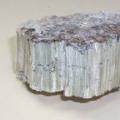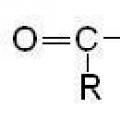Two dice are thrown randomly. Dice probability
In all tasks B6 on probability theory, which are presented in Open task bank for, you need to find probability any event.
You only need to know one formula, which is used to calculate probability:
In this formula p - probability of event,
k- the number of events that “satisfy” us, in language probability theory they're called favorable outcomes.
n- the number of all possible events, or number of all possible outcomes.
Obviously, the number of all possible events is greater than the number of favorable outcomes, so probability is a value that is less than or equal to 1.
If probability event value is 1, which means that this event will definitely happen. Such an event is called reliable. For example, the fact that after Sunday there will be Monday is, unfortunately, a reliable event and its probability is equal to 1.
The greatest difficulties in solving problems arise precisely with finding the numbers k and n.
Of course, as when solving any problems, when solving problems on probability theory you need to carefully read the condition in order to correctly understand what is given and what you need to find.
Let's look at a few examples of solving problems from from Open Bank tasks for .
Example 1. In a random experiment, two dice are rolled. Find the probability that the total will be 8 points. Round the result to hundredths.
Let the first die roll one point, then the second die can roll a 6 various options. So since the first die has 6 different sides, total number different options equals 6x6=36.
But we are not satisfied with everything. According to the conditions of the problem, the sum of the points drawn should be equal to 8. Let's create a table of favorable outcomes:

We see that the number of outcomes that suit us is 5.
Thus, the probability that a total of 8 points will appear is 5/36=0.13(8).
Once again we read the question of the problem: we need to round the result to hundredths.
Let's remember rounding rule.
We need to round to the nearest hundredth. If in the next place after the hundredths (that is, in the thousandths place) there is a number that is greater than or equal to 5, then we add 1 to the number in the hundredths place; if this number is less than 5, then we leave the number in the hundredths place unchanged.
In our case, the number in the thousandths place is 8, so we increase the number 3, which is in the hundredths place, by 1.
So, p=5/36 ≈0.14
Answer: 0.14
Example 2. 20 athletes are participating in the gymnastics championship: 8 from Russia, 7 from the USA, the rest from China. The order in which the gymnasts perform is determined by lot. Find the probability that the athlete competing first is from China.
In this problem, the number of possible outcomes is 20 - this is the number of all athletes.
Let's find the number of favorable outcomes. It is equal to the number of female athletes from China.
Thus,
Answer: 0.25
Example 3: On average, out of 1000 garden pumps sold, 5 leak. Find the probability that one pump randomly selected for control does not leak.
In this problem n=1000.
We are interested in pumps that do not leak. Their number is 1000-5=995. Those.
Tasks for probability of dice no less popular than coin toss problems. The condition of such a problem usually sounds like this: when throwing one or more dice(2 or 3), what is the probability that the sum of the points will be equal to 10, or the number of points will be 4, or the product of the number of points, or the product of the number of points divided by 2, and so on.
The application of the classical probability formula is the main method for solving problems of this type.
One die, probability.
The situation is quite simple with one dice.
is determined by the formula: P=m/n, where m is the number of outcomes favorable to the event, and n is the number of all elementary equally possible outcomes of the experiment with throwing a bone or cube.
Problem 1. The dice are thrown once. What is the probability of getting an even number of points?
Since the die is a cube (or it is also called a regular die, the die will land on all sides with equal probability, since it is balanced), the die has 6 sides (the number of points from 1 to 6, which are usually indicated by dots), this means that the problem has a total number of outcomes: n=6. The event is favored only by outcomes in which the side with even points 2,4 and 6 appears; the die has the following sides: m=3. Now we can determine the desired probability of the dice: P=3/6=1/2=0.5.
Task 2. The dice are thrown once. What is the probability that you will get at least 5 points?
Two dice, probability.
When solving problems involving throwing 2 dice, it is very convenient to use a special scoring table. On it, the number of points that fell on the first dice is displayed horizontally, and the number of points that fell on the second dice is displayed vertically. The workpiece looks like this:
But the question arises, what will be in the empty cells of the table? It depends on the problem that needs to be solved. If in the problem we're talking about about the sum of points, then the sum is written there, and if about the difference, then the difference is written down, and so on.
Problem 3. 2 dice are thrown at the same time. What is the probability of getting less than 5 points?
First, you need to figure out what the total number of outcomes of the experiment will be. Everything was obvious when throwing one dice 6 faces of the cube - 6 outcomes of the experiment. But when there are already two dice, the possible outcomes can be represented as ordered pairs of numbers of the form (x, y), where x shows how many points were rolled on the first dice (from 1 to 6), and y - how many points were rolled on the second dice (from 1 until 6). There will be a total of such number pairs: n=6*6=36 (in the table of outcomes they correspond exactly to 36 cells).
Now you can fill out the table; to do this, the number of points that fell on the first and second dice is entered in each cell. The completed table looks like this:

Using the table, we will determine the number of outcomes that favor the event “a total of less than 5 points will appear.” Let's count the number of cells, the value of the sum in which will be less number 5 (these are 2, 3 and 4). For convenience, we paint over such cells; there will be m=6 of them:

Considering the table data, probability of dice equals: P=6/36=1/6.
Problem 4. Two dice were thrown. Determine the probability that the product of the number of points will be divisible by 3.
To solve the problem, let's make a table of the products of the points that fell on the first and second dice. In it, we immediately highlight the numbers that are multiples of 3:

We write down the total number of outcomes of the experiment n=36 (the reasoning is the same as in the previous problem) and the number of favorable outcomes (the number of cells that are shaded in the table) m=20. The probability of the event is: P=20/36=5/9.
Problem 5. The dice are thrown twice. What is the probability that the difference in the number of points on the first and second dice will be from 2 to 5?
To determine probability of dice Let’s write down a table of point differences and select in it those cells whose difference value will be between 2 and 5:

The number of favorable outcomes (the number of cells shaded in the table) is m=10, the total number of equally possible elementary outcomes will be n=36. Determines the probability of the event: P=10/36=5/18.
In the case of a simple event and when throwing 2 dice, you need to build a table, then select the necessary cells in it and divide their number by 36, this will be considered a probability.
Left a reply Guest
With one dice the situation is indecently simple. Let me remind you that the probability is found by the formula P=m/n
P
=
m
n
, where n
n
is the number of all equally possible elementary outcomes of an experiment involving tossing a cube or dice, and m
m
- the number of outcomes that favor the event.
Example 1: The die is thrown once. What is the probability that an even number of points is rolled?
Since a die is a cube (they also say a regular die, that is, a balanced die so that it lands on all sides with equal probability), the cube has 6 faces (with a number of points from 1 to 6, usually indicated by points), then and the total number of outcomes in the problem n=6
n
=
6
. The only outcomes that favor the event are those where a side with 2, 4 or 6 points (even numbers only) appears; there are m=3 such sides
m
=
3
. Then the required probability is P=3/6=1/2=0.5
P
=
3
6
=
1
2
=
0.5
.
Example 2. A die is thrown. Find the probability of rolling at least 5 points.
We reason the same way as in the previous example. The total number of equally possible outcomes when throwing a die n=6
n
=
6
, and the condition “at least 5 points rolled”, that is, “either 5 or 6 points rolled” is satisfied by 2 outcomes, m=2
m
=
2
. The required probability is P=2/6=1/3=0.333
P
=
2
6
=
1
3
=
0.333
.
I don’t even see the point in giving more examples, let’s move on to two dice, where everything gets more interesting and complicated.
Two dice
When it comes to problems involving rolling 2 dice, it is very convenient to use a scoring table. Let us plot horizontally the number of points that fell on the first dice, and vertically the number of points that fell on the second dice. Let's get something like this (I usually do it in Excel, you can download the file below):
table of points for rolling 2 dice
What's in the table cells, you ask? And this depends on what problem we will solve. There will be a task about the sum of points - we will write the sum there, about the difference - we will write the difference and so on. Let's get started?
Example 3. 2 dice are thrown at the same time. Find the probability that the total will be less than 5 points.
First, let's look at the total number of outcomes of the experiment. when we threw one die, everything was obvious, 6 sides - 6 outcomes. There are already two dice here, so the outcomes can be represented as ordered pairs of numbers of the form (x,y)
x
,
y
, where x
x
- how many points were rolled on the first die (from 1 to 6), y
y
- how many points were rolled on the second dice (from 1 to 6). Obviously, there will be n=6⋅6=36 such pairs of numbers
n
=
6
⋅
6
=
36
(and exactly 36 cells in the table of outcomes correspond to them).
Now it's time to fill out the table. In each cell we enter the sum of the number of points rolled on the first and second dice and we get the following picture:
table of the sum of points when throwing 2 dice
Now this table will help us find the number of outcomes favorable to the event “a total of less than 5 points will appear.” To do this, we count the number of cells in which the sum value is less than 5 (that is, 2, 3 or 4). For clarity, let's color these cells, there will be m=6
m
=
6
:
table of total points less than 5 when throwing 2 dice
Then the probability is: P=6/36=1/6
P
=
6
36
=
1
6
.
Example 4. Two dice are thrown. Find the probability that the product of the number of points is divisible by 3.
We create a table of the products of the points rolled on the first and second dice. We immediately highlight those numbers that are multiples of 3:
Table of the product of points when throwing 2 dice
All that remains is to write down that the total number of outcomes is n=36
n
=
36
(see the previous example, the reasoning is the same), and the number of favorable outcomes (the number of shaded cells in the table above) m=20
m
=
20
. Then the probability of the event will be equal to P=20/36=5/9
P
=
20
36
=
5
9
.
As you can see, this type of problem, with proper preparation (let’s look at a couple more problems), can be solved quickly and simply. For variety, let’s do one more task with a different table (all tables can be downloaded at the bottom of the page).
Example 5: A die is thrown twice. Find the probability that the difference in the number of points on the first and second dice will be from 2 to 5.
Let's write down a table of point differences, highlight the cells in it in which the difference value will be between 2 and 5:
Table of difference of points when throwing 2 dice
So, the total number of equally possible elementary outcomes is n=36
n
=
36
, and the number of favorable outcomes (the number of shaded cells in the table above) m=10
m
=
10
. Then the probability of the event will be equal to P=10/36=5/18
P
=
10
36
=
5
18
.
So, in the case of throwing 2 dice and simple event, you need to build a table, select the necessary cells in it and divide their number by 36, this will be the probability. In addition to problems on the sum, product and difference of the number of points, there are also problems on the modulus of the difference, the smallest and largest number of points drawn (you will find suitable tables in the Excel file).
 Methods of studying history and modern historical science Classical and modern Russian historical science
Methods of studying history and modern historical science Classical and modern Russian historical science Strategy for the development of raw materials resources of the Urals
Strategy for the development of raw materials resources of the Urals Mesomeric effect, or how to draw resonant (boundary) structures In terms of resonance theory, explain the direction of the reaction
Mesomeric effect, or how to draw resonant (boundary) structures In terms of resonance theory, explain the direction of the reaction